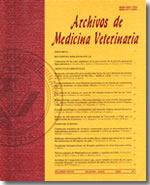Effects on cattle of transportation by road up to 36 hours with and without a rest on some blood variables indicator of stress
Main Article Content
Abstract
An experiment was carried out in winter (June - July) with the aim of determining the effects of transporting cattle for up to 36 hours with and without a resting period, on the blood concentrations of cortisol, glucose, ß-HBA, PCV values and blood CK activity.
Forty A. Angus and Hereford cross steers and heifers from the same farm with milk teeth or two teeth and a mean live weight of 400 kg were randomly divided into two groups of 20 animals each. They were transported during 36 hours with and without a resting period of eight hours after the first 24 h of journey. The animals were slaughtered following a lairage period of 12 h after arrival to the abattoir.
Blood samples were obtained from the jugular vein at the farm on their arrival to the resting station on arrival to the abattoir and finally at slaughter when the animals were bled. The blood cortisol concentrations were determined by radioimmunoassay (RIA); the glucose blood concentrations by the GOD PAP test without deprotenization (GL 2623, RANDOX); the ß-HBA by using the enzymatic technique that uses the ß-hidroxibutirate deshidrogenase enzyme for measuring the transformation from NAD+ to NADH; the PCV values by the microhematocrite technique and the CK blood activity was measured by the UV- kinetic method at 340 nm and 37 C. Descriptive statistics were used for analysing the results.To determine the differences between means, ANOVA was used and Kruskal-Wallis when the variances were not homogenous.
A high individual variation in response to stress for transport was observed. It can be concluded that transport for 36 h with or without a resting period was detrimental for the welfare of the animals. This is supported by the increase on the blood concentrations of cortisol, glucose and CK activity from the farm, to arrival at the abattoir and stunning. However, the resting period had a beneficial effect on the blood activity of CK and PCV values but to a lesser extent on fat mobilisation as reflected by the blood concentrations of ß-HBA at stunning.

